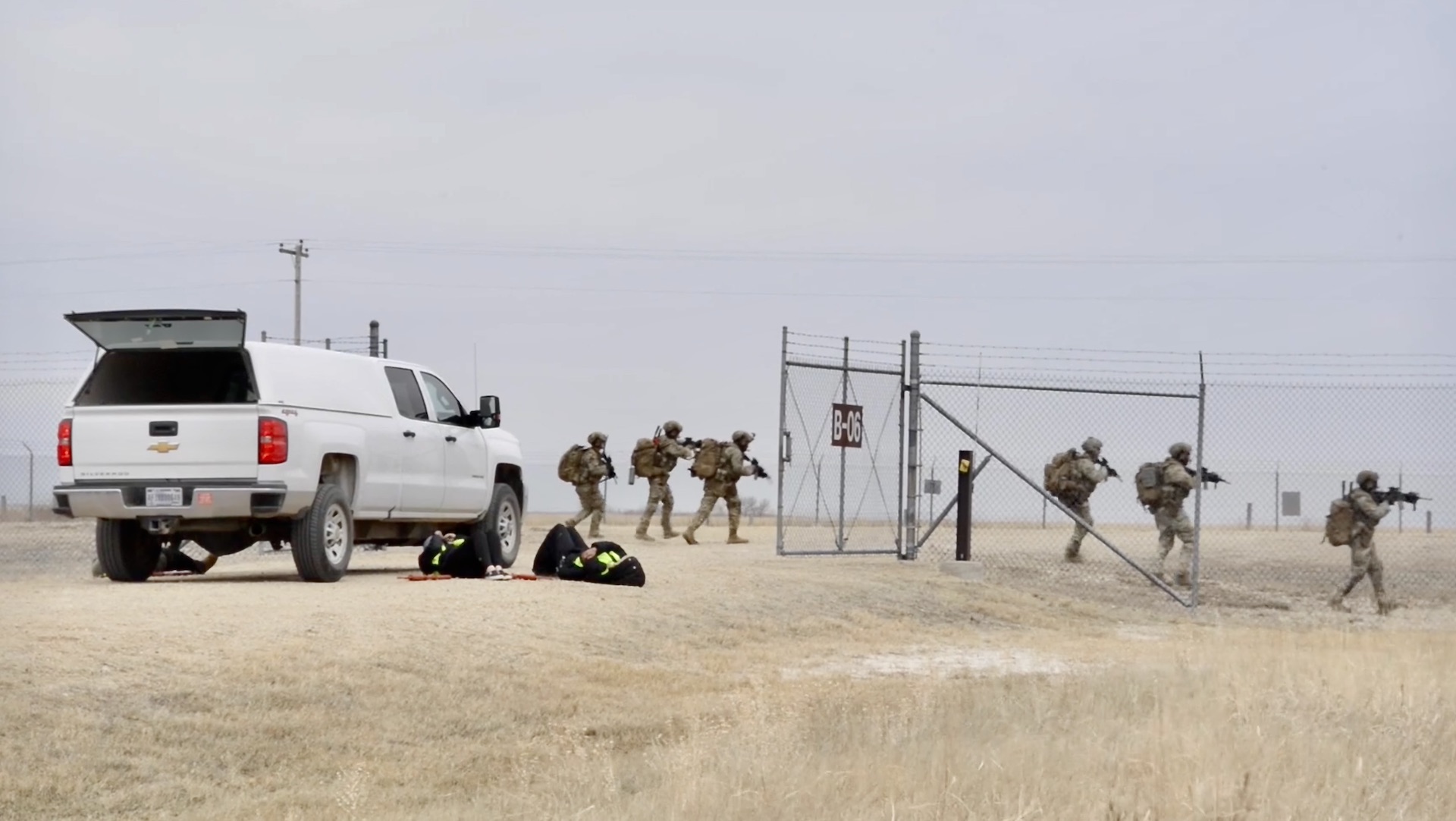As part of a recently released Air Force video, Security Forces personnel can be seen storming a Minuteman III intercontinental ballistic missile silo, and at several points disarming individuals role-playing the parts of armed intruders. These sorts of ‘recapture and recovery’ exercises, which are relatively routine for U.S. forces, allow security personnel to practice how a captured nuclear missile silo would be retaken if such an event came to pass.
Video of the exercise, which took place on April 28, was released by Air Force Global Strike Command (AFGSC) and gives us a detailed look at how these training operations play out. According to the video caption, the exercise occurred near Minot Air Force Base, North Dakota, and involved airmen assigned to the 91st Missile Security Operations Squadron Tactical Response Force (MSOS TRF) and Convoy Response Force (CRF). As footage of the missile silo’s entrance indicates, the exercise saw airmen practicing recapturing the LGM-30G Minuteman III ICBM silo B-06. B-06 houses one of 150 Minuteman III ICBMs under the control of the 91st Missile Wing, and is located near the town of Kongsberg, under 60 miles south of Minot AFB.
The original AFGSC video, posted to YouTube, can be seen below:

The video begins with two of the ‘intruders’ scouring the vicinity as they sit atop the missile silo. Wearing sunglasses and hoodies, the individuals are armed with fake/training rifles painted orange.

From there, a UH-1N Twin Huey helicopter – the Air Force, it should be noted, in the process of replacing its UH-1Ns with MH-139s – descends close to the silo site, dropping off four armed quick-reaction personnel. Additional troops are seen surrounding the outer perimeter of the missile silo.


Having subdued several individuals with fluorescent vests outside the entrance gate to B-06 – note the orange painted rifles left next to the captives on the ground – a team of airmen approach the missile silo and quickly descend underground.


With the missile silo ‘secure,’ various CRF vehicles – including Lenco BearCat armed vehicles as well as a number of up-armored High Mobility Multipurpose Wheeled Vehicles (HMMWVs) – approach the scene, offering additional armed support.

Toward the end of the video, one of the subdued ‘intruders’ is seen clearly with their dummy rifle casually laid next to them. We also see one of the orange painted rifles thrown through the air. This may have been part of the process of disarming the roleplayers, or it could have simply been part of the clean-up as the exercise was winding down.


The video caption further indicates that the training exercise took place in support of exercise Global Thunder 23 (GT23). GT23 is designed to assess joint operational readiness and provide training opportunities for USSTRATCOM forces to “deter, detect, and prevent strategic attacks against the U.S. and its allies,” according to the Air Force.
As Hans Kristensen, director of the Nuclear Information Project, Federation of American Scientists, told The War Zone, “it is hard to gauge how realistic it [the exercise] was or what the specific scenario was. … As for the wider significance, the exercise is part of the routine responsibility security forces have for protecting the 450 [nuclear missile] silos scattered around vast areas of the US mid-west.”
“Since this happened during a major STRATCOM nuclear forces exercise, the security exercise could potentially have simulated countering external threats or domestic terrorism seeking to prevent the intended operation of the silo. Although armed intruders would not be able to launch the missile, if they managed to get into the silo itself, they could potentially damage it with explosives,” he indicated.
Heightened security around nuclear missile silos, including at Minot AFB, remains critical to keeping these sites safe from potential armed intruders. Airmen attached to the 91st TRF play a significant role to this end, and receive specialist training on how to handle potential incidents like the one simulated on April 28.

“TRF is like the tactical commander’s SWAT team if compared to civilian law enforcement,” Col. Chad Gallagher, then-commander of the 91st Security Forces Group, noted in an interview back in 2018. “They get additional training, have more capabilities and a better sense of teamwork as a small unit. If a unit [in the missile field] faces a force that they can’t handle themselves, they call in TRF.”
Alongside extensive training on the defense of missile silos, as well as training on how to recapture and recover them from armed assailants, the unit also conducts training on escorting nuclear convoys to and from launch facilities using various armed vehicles. It’s likely that, along with Air Force units more broadly, airmen with the 91st TRF will soon be getting their hands on new JLTVs which could supplement or supplant their existing Humvees in training and other operations.
Moreover, with silo-based ICBMs set to be a core component of the USAF and the U.S. nuclear deterrent arsenal for the foreseeable future, the need to defend them with the latest technologies remains critical. As The War Zone has noted, the LGM-30G Minuteman III – first introduced in 1970 and the only land-based ICBM in service in the U.S. – is in the process of being modernized and will eventually be replaced by new LGM-35A Sentinel ICBMs. Indeed, while the Air Force has explored alternatives to traditional nuclear missile silos as of late – such as basing missiles in tunnels or at the bottom of deep lakes – the service has ultimately opted to retain its ground-based silos when it introduces new Sentinal ICBMs.
With that said, the 91st TRF performs an essential duty in providing security to Minot AFB’s nuclear missile silos – and will likely continue to do so in the years to come.
Contact the author: oliver@thewarzone.com
